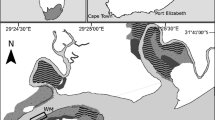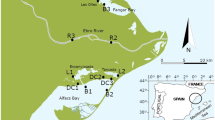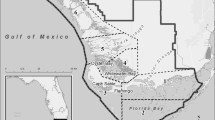Abstract
Brown shrimp (Farfantepenaeus aztecus) are an important commercial aquatic species experiencing loss of inshore marsh nursery habitat in coastal Louisiana. To study inshore brown shrimp movements and identify aspects of essential habitat important for sustaining brown shrimp populations, we collected juvenile brown shrimp in April and May 2000, the time of annual maximum brown shrimp abundance, in a small 1-km2 marsh area on the central Louisiana coast. Drop sampling showed average shrimp densities of 1.6–2.4 m−2 in shallow marsh ponds and seining indicated lower densities of 0.5–0.9 m−2 in nearby shallow channel and open bay sites. Smaller shrimp (< 50 mm) fed disproportionately on benthic diatoms and small harpacticoid copepods, while large shrimp fed more frequently on larger-bodied amphipods and tanaids. We developed novel chemical approaches to estimate patterns of shrimp residency and movement using carbon and nitrogen stable isotopic determinations. Resident shrimp had isotopic values similar to average foods and showed consistent isotopic spacings between fast and slow turnover tissues. Residency was highest (47–55%) in ponds and shallow channel habitats and much less in open bays and deep channels (4–27%). There was sparse evidence for dietary specialization among individull shrimp. The results support the view that small 10–20 mm postlarval and juvenile brown shrimp arriving in estuaries from offshore waters continue movement through sub-optimal habitats (deep channels and open bays), but exhibit much less movement once an optimal habitat (marsh ponds or shallow channel margins) is reached. This study also indicated that combining estimates of shrimp densities, residency, growth rate, and mortality allows evaluation of the importance of different habitat types for shrimp production. Shallow ponds that in many ways resemble fertile aquaculture ponds appear to be hot spots for brown shrimp production, and coastal preservation and restoration efforts should focus on these areas as important for sustaining shrimp fisheries.
Similar content being viewed by others
Literture Cited
Abrajano, T. A., D. E. Murphy, J. Fang, P. Comet, andM. M. Brooks. 1994.13C/12C ratios in individual fatty acids of marine mytilids with and without bacterial symbionts.Organic Geochemistry 21:611–617.
Anderson, R. K., P. L. Parker, andA. Lawrence. 1987. A13C/12C study of the utilization of presented feed by a commercially important shrimpPenaeus vannamei in a pond growout system.Journal of The World Aquaculture Society 18:148–155.
Baltz, D. M., C. F. Rakocinski, andJ. W. Fleeger. 1993. Microhabitat use by marsh-edge fishes in a louisiana estuary.Environmental Biology of Fishes 36:109–126.
Barrie, A. andS. J. Prosser. 1996. Automated analysis of light-element stable isotopes by isotope ratio mass spectrometry, p. 1–46.In T. W. Boutton and S. Yamasaki (eds.), Mass Spectrometry of Soils, Mercel Dekker, New York.
Boesch, D. F. andR. E. Turner. 1984. Dependence of fishery species on salt marshes: The role of food and refuge.Estuaries 7:460–468.
Britsch, L. D., andJ. B. Dunbar. 1993. Land loss rates: Louisiana Coastal Plain.Journal of Coastal Research 9:324–338.
Brownder, J. A., L. N. May, Jr.,A. Rosenthal, J. G. Gosselink, andR. H. Baumann. 1989. Modeling future trends in wetland loss and brown shrimp production in Louisiana using thematic mapper imagery.Remote Sensing of the Enviroment 28:45–59.
Buffan-Dubau, E., andK. R. Carman. 2000. Diel feeding behavior of meiofauna and their relationships with microalgal resources.limnology and Oceanography 45:381–395.
Carman, K. R. andB. Fry. 2002. Small-sample methods for δ13C and δ15N analysis of the diets of marsh meiofaunal species using natural-abundance and tracer-addition isotope techniques.Marine Ecology Progress Series 240:85–92.
Currin, C. A., S. Y. Newell, andH. W. Paerl. 1995. The role of standing deadSpartina alterniflora and benthic microalgae in salt marsh foods webs: Considerations based on multiple stable isotope analysis.Marine Ecology Progress Series 121:99–116.
Day, Jr.,J. W., G. P. Shaffer, D. J. Reed, D. R. Cahoon, L. D. Britsch, andS. R. Hawes. 2001. Patterns and processes of wetland loss in coastal Louisiana are complex: A reply to Turner 2001.Estuaries 24:647–651.
Fantle, M. S., A. I. Dittel, S. M. Schwalm, C. E. Epifanio, andM. L. Fogel. 1999. A food web analysis of the juvenile blue crab,Callinectes sapidus using stable isotopes in whole animals and individual amino acids.Oecologia (Berlin) 120:416–426.
Feller, R. J. andB. C. Coull. 1995. Non-selective ingestion of meiobenthos by juvenile spot (Leiostomus xanthurus) (Pisces) and their daily ration.Vie et Milieu 45:49–60.
Fry, B. 1983. Fish and shrimp migrations in the northern Gulf of Mexico analyzed using stable C, N, and S isotope ratios.Fishery Bulletin 81:789–801.
Fry, B., R. K. Andersen, L. Entzeroth, J. L. Bird, andP. L. Parker. 1984.13C enrichment and oceanic food web structure in the northwestern Gulf of Mexico.Contributions in Marine Science 27:49–63.
Fry, B. andC. Arnold. 1982. Rapid13C/12C turnover during growth of brown shrimp (Penaues aztecus).Oecologia (Berlin) 54:200–204.
Fry, B., S. A. Macko, andJ. C. Zieman. 1987. Review of stable isotopic investigations of food webs in seagrass meadows, p. 189–209.In M. J. Durako, R. C. Phillips, and R. R. Lewis (eds.), Florida Marine Research Publications, Volume 42. Florida Department of Natural Resources, St. Petersburg, Florida.
Fry, B., P. L. Mumford, andM. B. Robblee. 1999a. Stable isotope studies of pink shrimp (Farfantepenaeus durorarum Burkenroad) migrations on the southwestern Florida shelf.Bulletin of Marine Science 65:419–430.
Fry, B., P. L. Mumford, F. Tam, D. D. Fox, G. L. Warren, K. E. Havens, andA. D. Steinman. 1999b. Trophic position and individual feeding histories of fish from Lake Okeechobee, Florida.Canadian Journal of Fisheries and Aquatic Science 56:590–600.
Fry, B., andE. Sherr. 1984. δ13C measurements as indicators of carbon flow in marine and freshwater ecosystems.Contributions in Marine Science 27:13–47.
Gilmour, I., M. A. Johnston, C. T. Pillinger, M. M. Pond, C. A. Mattacks, andP. Prestrud. 1995. The carbon isotopic composition of individual fatty acids as indicators of dietary history in arctic foxes on Svalbard.Philosophical Transaction of the Royal Society of London B 349:135–142.
Gleason, D. F. 1986. Utilization of salt marsh plants by postlarval brown shrimp: Carbon assimilation rates and food preferences.Marine Ecology Progress Series 31:151–158.
Gleason, D. F., andG. M. Wellington. 1988. Food resources of postlarval brown shrimp (Penaeus aztecus) in a Texas salt marsh.Marine Biology 97:329–337.
Haas, H. L., E. C. Lamon, III,K. A. Rose, andR. R. Shaw. 2001. Environmental and biological factors associated with stage-specific brown shrimp abundances in Louisiana: Applying a new combination of statistical techniques to long-term monitoring data.Canadian Journal of Fisheries and Aquatic Sciences 58:2258–2270.
Hammer, B. T., M. L. Fogel, andT. C. Hoering. 1998. Stable carbon isotope ratios of fatty acids in seagrass and redhead ducks.Chemical Geology 152:29–41.
Hart, E. A., andJ. R. Lovvorn. 2002. Interpreting stable isotopes from macroinvertebrate foodwebs in saline wetlands.Limnology and Oceanography 47:580–584.
Heard, R. W. 1982. Guide to common tidal marsh invertebrates of the northeastern Gulf of Mexico. Sea Grant Consortium MASP-79-004. Mississippi-Alabama Sea Grant Consortium, Reinbold Lithographing and Printing Co., Booneville, Mississippi.
Hoyt, M., J. W. Fleeger, R. Siebeling, andR. J. Feller. 2000. Serological estimation of prey-protein gut-residence time and quantification of meal size for grass shrimp consuming meiofaunal copepods.Journal of Experimental Marine Biology and Ecology 248:105–119.
Huys, R., J. M. Gee, C. G. Moore, andR. Hamond. 1996. Marine and brackish water harpacticoid copepods. Part 1, p. 1–352.In Synopses of the British Fauna. The Linnean Society of London. London, U.K.
Kneib, R. T. 1995. Behaviour separates potential and realized effects of decapod crustaceans in salt marsh communities.Journal of Experimental Marine Biology and Ecology 193:239–256.
Kneib, R. T. 1997. The role of tidal marshes in the ecology of estuarine nekton.Oceanography and Marine Biology: An Annual Review 35:163–220.
Knudsen, E. E., W. H. Herke, andJ. M. Mackler. 1977. The growth rate of marked juvenile brown shrimp,Penaeus aztecus, in a semi-impounded Louisiana coastal marsh.Proceedings of the 29th Annual Gulf and Caribbean Fisheries Institute 29:144–159.
McTigue, T. A., andR. J. Zimmerman. 1998. The use of infauna by juvenilePenaeus aztecus Ives andPenaeus setiferus (Linnaeus).Estuaries 21:160–175.
Minagawa, M., andE. Wada. 1984. Stepwise enrichment of15N along food chains: Further evidence and the relation between δ15N and animal age.Geochimica et Cosmochimica Acta 48:1135–1140.
Minello, T. J. 1999. Nekton densities in shallow estuarine habitats of Texas and Louisiana and the identification of essential fish habitat.American Fisheries Society Symposium 22:43–75.
Minello, T. J., R. J. Zimmerman, andE. X. Martinez. 1989. Mortality of young brown shrimpPenaeus aztecus in estuarine nurseries.Transactions of the American Fisheries Society 118:693–708.
Minello, T. J., R. J. Zimmerman, andM. Medina. 1994. The importance of edge for natant macrofauna in a created salt marsh.Wetlands 14:184–198.
Moore, L. E., D. M. Smith, andN. R. Loneragan 2000. Blood refractive index and whole-body lipid content as indicators of nutritional condition for penaeid prawns (Decapoda: Penaeidae).Journal of Experimental Marine Biology and Ecology 244: 131–143.
O'Reilly, C. M., R. E. Hecky, A. S. Cohen, andP.-D. Plisnier. 2002. Intrepreting stable isotopes in food webs: Recognizing the role of time averaging at different trophic levels.Limnology and Oceanography 47:306–309.
Parker, P. L., R. K. Anderson, andA. L. Lawrence. 1991. Stable isotope methodology for evaluation of nutritional requirement of shrimp, p. 157–171.In P. DeLoach, W. J. Dougherty, and M. A. Davidson (eds.), Frontiers in Shrimp Research. Elsevier Science Publishers, Amsterdam, The Netherlands.
Peterson, G. W., andR. E. Turner. 1994. The value of salt marsh edge versus interior as a habitat for fish and decapod crustaceans in a Louisiana tidal marsh.Estuaries 17:235–262.
Reyes, E., J. F. Marin, M. L. White, J. W. Day, andG. P. Kemp. 2000. Landscape modeling of coastal habitat change in the Mississippi delta.Ecology 81:2331–2349.
Rozas, L. P. 1995. Hydroperiod and its influence on nekton use of the salt marsh: A pulsing ecosystem.Estuaries 18:579–590.
Rozas, L. P., andT. J. Minello. 1997. Estimating densities of small fishes and decapod crustaceans in shallow estuarine habitats: A review of sampling design with focus on gear selection.Estuaries 20:199–213.
Rozas, L. P., andT. J. Minello. 1998. Nekton use of salt marsh, seagrass, and nonvegetated habitats in a south Texas (USA) estuary.Bulletin of Marine Science 6:481–501.
Rozas, L. P., andD. J. Reed. 1993. Nekton use of marsh-surface habitats in Louisiana (USA) deltaic salt marshes undergoing submergence.Marine Ecology Progress Series 96:147–157.
Ruiz, G. M., A. H. Hines, andM. H. Posey. 1993. Shallow water as a refuge habitat for fish and crustaceans in non-vegetated estuaries: An example from Chesapeake Bay.Marine Ecology Progress Series 99:1–16.
Tieszen, L. L., T. W. Boutton, K. G. Tesdahl, andN. A. Slade. 1983. Fractionation and turnover of stable carbon isotopes in animal tissues: Implications for δ13C analysis of diet.Oecologia (Berlin) 57:32–37.
Tieszen, L. L., andT. Fagre. 1993. Effect of diet quality and composition on the isotopic composition of respiratory CO2, bone collagen, bioapatite and soft tissues, p. 121–154.In J. B. Larnbert and G. Grupe (eds.), Prehistoric Human Bone: Archaeology at the Molecular Level. Springer Verlag, Berlin, Germany.
Turner, R. E. 1977. Intertidal vegetation and commercial yields of penaeid shrimp.Transactions of the American Fisheries Society 106:411–416.
Turner, R. E. 1992. Coastal wetlands and penaeid shrimp habitat, p. 97–104.In R. H. Stroud (ed.) Stemming the Tide of Coastal Fish Habitat Loss. Proceedings of the Symposium on the Conservation of Coastal Fish Habitat. National Coalition for Marine Conservation, Savannah, Georgia.
Turner, R. E. 2001. Estimating the indirect effects of hydrologic change on wetland loss: If the earth is curved, then how would we know it?Estuaries 24:639–646.
U.S. Geological Survey. 1999, 1988. Gulf of Mexico Coastal Louisiana Habitat Data as Raster Image. UTM 15 NAD83. U.S. Geological Survey, National Wetlands Research Center, Lafayette, Louisiana [nwihab88].
Wells, J. B. J. 1976. Keys to the Aid in the Identification of Marine Harpacticoid Copepods. Department of Zoology, University of Aberdeen, Aberdeen, U.K.
Source of Unpublished Materials
Carman, K. Personal communication. Department of Biological Sciences, Louisiana State University, Baton Rouge, Louisiana 70803.
Author information
Authors and Affiliations
Rights and permissions
About this article
Cite this article
Fry, B., Baltz, D.M., Benfield, M.C. et al. Stable isotope indicators of movement and residency for brown shrimp (Farfantepenaeus aztecus) in coastal Louisiana marshscapes. Estuaries 26, 82–97 (2003). https://doi.org/10.1007/BF02691696
Received:
Revised:
Accepted:
Issue Date:
DOI: https://doi.org/10.1007/BF02691696




